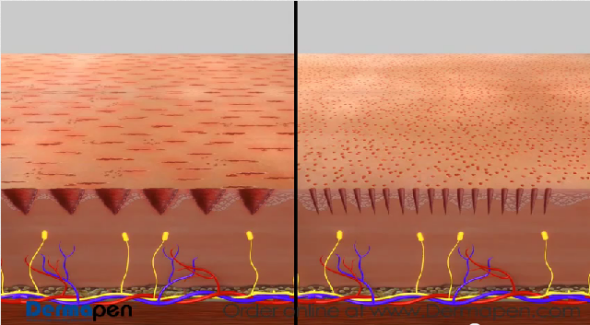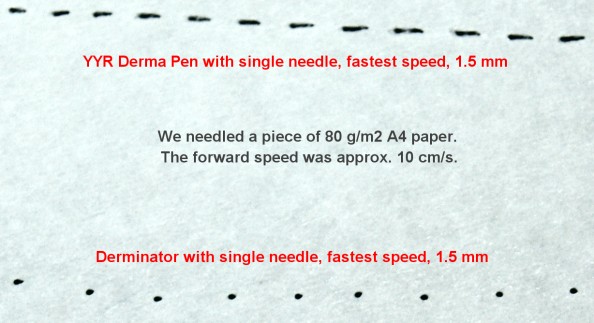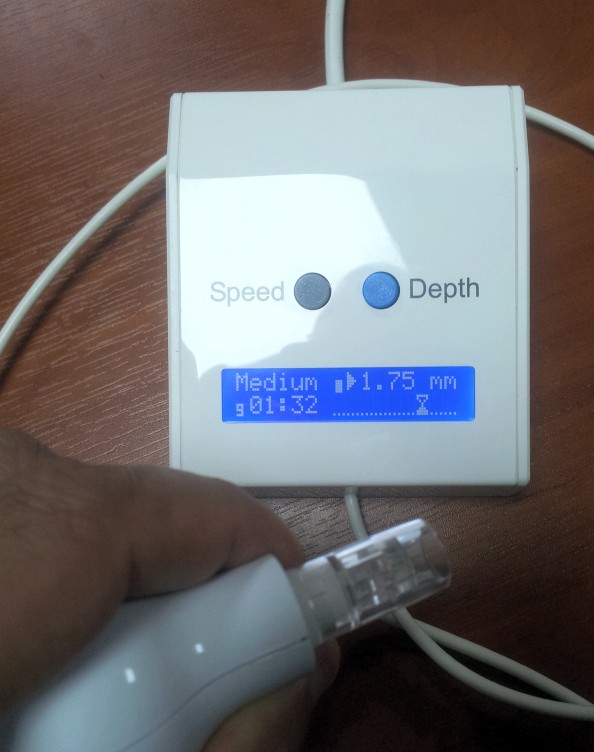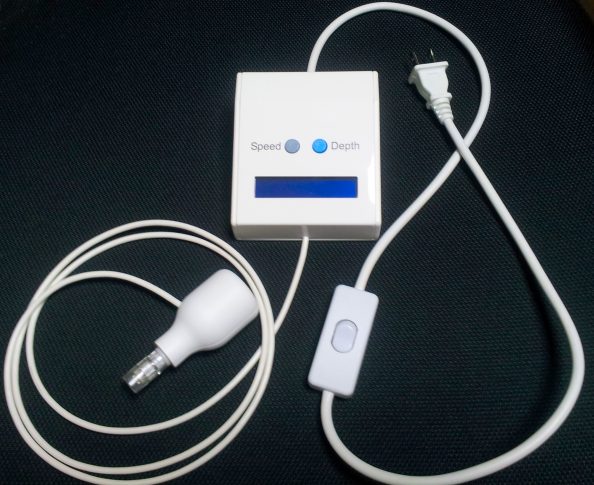Dermapen can cause skin micro-tearing but the Derminator® won't
It is an age-old phenomenon: Something cheap and useful comes along, it becomes popular, and then what happens is always the same: A "more advanced" version is agressively marketed to the happy users of the cheap, simple, effective product. It's a proven concept. People will think: "Wow, that's a genius idea - if a manual needling instrument has improved my skin so much already, imagine how much easier and better things will be with one of those!"
Well, potentially, yes. In principle. But not yet. There are no safe "derma-pens" yet. Update 2 years after this article was written: We developed our own machine that does not cause tearing! See below.
Some years ago, we wanted to develop and market an automatic dermastamp (like a tattoo machine). We thought that would be an excellent idea, and in principle it is, but in practice there is a big problem: Tearing of the skin.
Because with an electric dermastamp (Derma-pen etc.), it is you who moves the device over the skin, instead of the device moving "itself", as a train on rails or, a better analogy, a cog over another cogwheel. It is you who moves a dermaroller, but the dermaroller moves always in an unchangable way - straight ahead, and there are always a few rows of needles at any one time burrowed into the skin. That is very important, because that principle ensures that it is impossible to cause skin tearing. When the "back row" of needles it being lifted out of the skin, they can't tear the skin, because the "middle row" and "front row" are securing the dermaroller firmly in place. The little vertical movement of the needles that is possible with the dermarolling method remains within the flexibility limits of even the least flexible skin.

Source: Youtube video uploaded by Dermapen®, used in Fair Use (review purposes). URL: https://youtube.com/watch?feature=player_detailpage&v=29bWwHzl1ec
Not so with the Dermapen. The dermapen is an automatic dermastamp, like a tattoo machine with many needles. The big drawback with that system is that you can move it into any direction with any speed, and that while you're moving it, the needles go in and out at a very high speed. The speed of the needles is independent of the speed you're moving the pen with. That is the opposite of what happens with a dermaroller. A dermaroller's needles move with the exact same speed you're moving the roller head with, because the needles are moved by you moving the roller head. Skin tearing is absolutely impossible with a dermaroller (or manual dermastamp), by its very design. Its needles pierce the skin, slide in and out without possibility to move sideways because the other needles anchor the roller head to the skin.
It's not "coring out" the skin that we're trying to achieve, but making "channels". The idea is to cause just the right amount of inflammation while causing the least possible skin trauma.
A tear is horizontal and a channel is vertical.
There are many reasons why we only want vertical channels and not horizontal tears:
1) Because of its verticalness, a channel's visible surface is much smaller than a tear's visible surface. This is important due to the fact that we want to minimize scarring in susceptible individuals.
2) A tear causes much more skin trauma and thus involves a greater likelihood of scarring than a channel, because a channel is made by piercing the skin with a needle, whereas a tear is made by pulling the blunt side of the needle through the skin.
3) Because of the horizontal orientation of nerves in the skin, tears have a much higher statistical likelihood to cause pain than channels, even though the nerves reside deeper than the needling depth, tears cause shearing forces on them. I think that a lot of the pain from dermaneedling is caused by lateral forces.
4) Because of the horizontal orientation of capilaries in the skin, tears have a much higher statistical likelihood to cause bleeding than channels.
5) Micro-tears can rip the edge of pores, permanently enlarging them. The nature of holes made out of collagen and elastin is such that when you make a sideways cut through their boundary, that the sideways stresses by the skin around the hole causes the hole to enlarge. The remodeling hapens, and the hole is permanently enlarged. This means that microtearing on facial skin can cause permanently enlarged pores in susceptible individuals.
Here you can see how cheap Chinese "buzzers" tear the skin:

Years ago, we already warned against using a tattoo machine, exactly because of the inevitability of skin tearing (so small you won't see or notice it, but it happens nevertheless). The duty cycle of a tattoo machine's needles (or of a dermapen's needles) is not suitable for skin needling. A tattoo is not intended to improve your skin! Tattooing is not the same as collagen regeneration. "Duty cycle" means in this case how many percent of the time the needle is down. With a dermapen, the needles are more or less fully down 25% of the time, more or less fully up 25% of the time, and somewhere in between 50% of the time. Approx. 10% of the latter 50%, the needles are scratching over your skin, while you move the dermapen. And while the needles are down (approx. 25% of the time), you are also moving the device, causing skin tears because a dermapen's needles always point straight down. By design, its needles can't "slide out" of the skin. So what you do is causing small horizontal tears in the skin, even when you move it quite slowly and that is totally inevitable, no matter what setting you use. It would be theoretically avoidable, if the dermapen would have a different duty cycle but that would require a strong spring combined with an extremely strong electromagnet. That way, the needles would be down into the skin only 5% of the time or less, and that would be sufficient to avoid microtearing. The very strong electromagnet would be able to quickly pull the needles up, yielding a spike-patterns instead of oscillating in a sinoid pattern. The strong spring would push the needles very quickly down. That combo would be able to have the short duty-cycle required to avoid microtearing. However, such a device would be much more expensive to produce and bulkier and heavier than the currently available dermapens that use cheap, simple technology. We have done a dermapen test and those devices suffer from the micro-tearing issue, because their technology is lacking. Their needle's down-cycle lasts too long, causing skin micro-tearing.
In my opinion, the companies that market gimmicks such as the Dermapen® know nothing about dermaneedling, but they know everything about marketing and they have very large budgets for it. Their public relations advisors often seem to think that to attack is the best defense, so what the manufacturers of the Dermapen® did was hire an animation studio and instructed them to visualize "how a dermaroller causes skin tearing, whilst a Dermapen® doesn't". They did a good job - it sure looks scary to me.
 Now is the time to remind our readers that in an animation, one can make things happen that aren't real. I can't count the times that Wile E. Coyote has been blown up by Roadrunner or Bugs Bunny. The manufacturer of the Dermapen® employs a particularly devious form of marketing: Bringing a flawed product to market and then accusing everyone else of having their flaw. FUD-generator on overdrive. These people have no clue about dermaneedling, or they just don't care - or both, or worse. We keep being amazed at the absence of even subsistence levels of ethics in this field. We see it time and time again and people keep falling for it: Business people trying to grab a substantial piece of the pie, using dirty tricks to gain market share. Disinformation techniques have to compensate for incompetence and greed. They want your money and they will say anything to get it. And every time we expose some inconvenient truth on our site, we get threatened with a lawsuit. (They just threatened us with one, as predicted.) Those marketing wizards have a lot of money for advertising and lawyers - because they need it. We use word-of-mouth only, so our customers don't pay our advertising expenses. Their business model doesn't work that way.
Now is the time to remind our readers that in an animation, one can make things happen that aren't real. I can't count the times that Wile E. Coyote has been blown up by Roadrunner or Bugs Bunny. The manufacturer of the Dermapen® employs a particularly devious form of marketing: Bringing a flawed product to market and then accusing everyone else of having their flaw. FUD-generator on overdrive. These people have no clue about dermaneedling, or they just don't care - or both, or worse. We keep being amazed at the absence of even subsistence levels of ethics in this field. We see it time and time again and people keep falling for it: Business people trying to grab a substantial piece of the pie, using dirty tricks to gain market share. Disinformation techniques have to compensate for incompetence and greed. They want your money and they will say anything to get it. And every time we expose some inconvenient truth on our site, we get threatened with a lawsuit. (They just threatened us with one, as predicted.) Those marketing wizards have a lot of money for advertising and lawyers - because they need it. We use word-of-mouth only, so our customers don't pay our advertising expenses. Their business model doesn't work that way.
Update: Years after writing this, we finally are about to launch our own device, the Derminator®. Here you can read all info on this fully digital dermaneedling device. Some pictures of how the first versions of the machine looked, in December 2014:




















